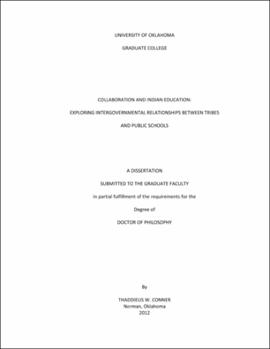| dc.contributor.advisor | Fryar, Alisa H. | |
| dc.creator | Conner, Thaddieus | |
| dc.date.accessioned | 2019-04-27T21:35:46Z | |
| dc.date.available | 2019-04-27T21:35:46Z | |
| dc.date.issued | 2012 | |
| dc.identifier | 99321082502042 | |
| dc.identifier.uri | https://hdl.handle.net/11244/319100 | |
| dc.description.abstract | The education of American Indian students in public schools requires the coordinated effort of managers at multiple levels of government including tribal, local, state, and federal. With more than 90% of American Indian students served in public schools in the United States, the strength of these relationships are argued to be critical in ensuring that local school officials adequately meet the unique cultural and academic needs of Native students. However, little is known about the nature of these relationships, and what effect government-to-government collaboration has on Native student outcomes. This dissertation seeks to address this dearth of knowledge and explores the relationship between tribes and public schools in New Mexico and Oklahoma, two of the largest states in the nation with regards to Native student enrollment in the public school system. | |
| dc.description.abstract | This analysis of the relationship between tribes and public schools draws from a number of sub-literatures in public administration and public policy, including theories of collaborative public management, representative bureaucracy, and social construction theory. In recent years, a number of scholars in public administration have called for greater attention paid to issues of tribal governance, with some referring to tribes as a "fourth player" in the intergovernmental relations framework. As one of the first major studies to explore the relationship between tribes and local education agencies from a public administration perspective, the analysis offers a unique attempt to model both the nature and impact of tribal-local partnerships on policy outcomes using a mixed methods approach. This study uses a combination of qualitative interviews with tribal leaders and quantitative data from a unique mail survey of 150 Indian education directors in New Mexico and Oklahoma public schools, as well as secondary data on various school district characteristics. | |
| dc.description.abstract | From a substantive standpoint, this analysis also adds to our understanding of what factors are important to the strength of intergovernmental partnerships with tribes, and what this means for improving the ability of public agencies to better serve tribal communities and close persisting achievement gaps between Native and non-Native students. Chapter III highlights the issues and challenges associated with building meaningful partnerships between tribes and public schools, while Chapter IV explores the role of values and beliefs in the collaborative process. Chapter V builds on this analysis and demonstrates how collaboration between Native communities and local education agencies impacts perceived improvements in Indian education. Overall, the analysis demonstrates the leverage researching relationships between tribes and public schools can offer existing theory in both public administration and public policy, and introduces a framework for incorporating tribes into the broader intergovernmental relations discussion. | |
| dc.format.extent | 160 pages | |
| dc.format.medium | application.pdf | |
| dc.language | en_US | |
| dc.relation.requires | Adobe Acrobat Reader | |
| dc.subject | Indians of North America--New Mexico--Government relations | |
| dc.subject | Indians of North America--Oklahoma--Government relations | |
| dc.subject | School boards--New Mexico | |
| dc.subject | School boards--Oklahoma | |
| dc.subject | Intergovernmental cooperation--New Mexico | |
| dc.subject | Intergovernmental cooperation--Oklahoma | |
| dc.subject | I | |
| dc.title | Collaboration and Indian Education: Exploring Intergovernmental Relationships Between Tribes and Public Schools | |
| dc.type | text | |
| dc.type | document | |
| dc.thesis.degree | Ph.D. | |
| ou.group | College of Arts and Sciences::Department of Political Science | |
